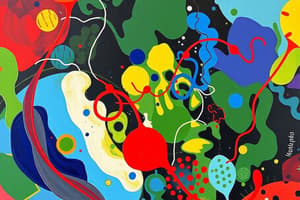Podcast
Questions and Answers
Which of the following statements accurately describes the role of oxidoreductase in the electron transport chain (ETC)?
Which of the following statements accurately describes the role of oxidoreductase in the electron transport chain (ETC)?
- It directly facilitates the movement of protons across the inner mitochondrial membrane.
- It functions as a structural component within the protein to encourage electron movement.
- It acts as a catalyst for both oxidation and reduction reactions necessary for electron transfer. (correct)
- It solely provides the necessary coenzymes for electron attachment without affecting redox reactions.
In complex I of the electron transport chain, what is the correct sequence of electron transfer among its components?
In complex I of the electron transport chain, what is the correct sequence of electron transfer among its components?
- NADH -> FMN -> Fe-S -> CoQ (correct)
- NADH -> Fe-S -> FMN -> CoQ
- NADH -> FMN -> CoQ -> Fe-S
- NADH -> CoQ -> FMN -> Fe-S
Which of the following is a key distinction between electron transport via NADH and FADH2 in the electron transport chain?
Which of the following is a key distinction between electron transport via NADH and FADH2 in the electron transport chain?
- NADH transfers electrons directly to complex II, while FADH2 starts at complex I.
- NADH requires ubiquinone for electron transfer, while FADH2 uses cytochrome C.
- NADH generates fewer ATP molecules compared to FADH2 due to bypassing complex I.
- NADH initiates electron transport at complex I, whereas FADH2 enters at complex II. (correct)
What is the primary role of ubiquinone (CoQ) in the electron transport chain?
What is the primary role of ubiquinone (CoQ) in the electron transport chain?
During the Q cycle in complex III, what is the immediate fate of the two electrons released from QH2?
During the Q cycle in complex III, what is the immediate fate of the two electrons released from QH2?
Which of the following best describes the role of cytochrome c in the electron transport chain?
Which of the following best describes the role of cytochrome c in the electron transport chain?
What is the significance of Complex II not spanning the mitochondrial membrane, unlike Complexes I, III, and IV?
What is the significance of Complex II not spanning the mitochondrial membrane, unlike Complexes I, III, and IV?
What is the final electron acceptor in the electron transport chain, and what product does it form upon accepting electrons?
What is the final electron acceptor in the electron transport chain, and what product does it form upon accepting electrons?
In Complex IV, how many electrons are ultimately required to fully reduce one molecule of dioxygen (O2)?
In Complex IV, how many electrons are ultimately required to fully reduce one molecule of dioxygen (O2)?
What is the significance of the iron atom's oxidation state in cytochrome c during electron transport?
What is the significance of the iron atom's oxidation state in cytochrome c during electron transport?
If an inhibitor blocks Complex IV of the electron transport chain, what would be the expected state of the components upstream of the block?
If an inhibitor blocks Complex IV of the electron transport chain, what would be the expected state of the components upstream of the block?
What is the approximate ATP yield from the passage of two electrons through the electron transport chain when the electron source is NADH?
What is the approximate ATP yield from the passage of two electrons through the electron transport chain when the electron source is NADH?
Why is the actual ATP yield from the electron transport chain less than the theoretical yield?
Why is the actual ATP yield from the electron transport chain less than the theoretical yield?
Under anaerobic conditions, the electron transport chain is unable to operate. What initial change would be observed?
Under anaerobic conditions, the electron transport chain is unable to operate. What initial change would be observed?
A researcher introduces an inhibitor to Complex I. Which of the following would accurately describe the state of the electron carriers?
A researcher introduces an inhibitor to Complex I. Which of the following would accurately describe the state of the electron carriers?
Flashcards
Oxidoreductase
Oxidoreductase
A compound that transfers electrons by oxidizing one substance and reducing another.
Complex I
Complex I
Accepts electrons from NADH and donates electrons to CoQ. Contains FMN and iron-sulfur clusters.
Complex II
Complex II
Contains succinate and iron-sulfur clusters. Accepts electrons from succinate.
Complex III
Complex III
Signup and view all the flashcards
Complex IV
Complex IV
Signup and view all the flashcards
FMN
FMN
Signup and view all the flashcards
Fe-S clusters
Fe-S clusters
Signup and view all the flashcards
Succinate dehydrogenase
Succinate dehydrogenase
Signup and view all the flashcards
CoQ (Ubiquinone)
CoQ (Ubiquinone)
Signup and view all the flashcards
Q cycle
Q cycle
Signup and view all the flashcards
Determining ETC arrangement
Determining ETC arrangement
Signup and view all the flashcards
Methemoglobin
Methemoglobin
Signup and view all the flashcards
Proton pumping
Proton pumping
Signup and view all the flashcards
Efficiency of ETC
Efficiency of ETC
Signup and view all the flashcards
Inhibitors of ETC
Inhibitors of ETC
Signup and view all the flashcards
Study Notes
null
Studying That Suits You
Use AI to generate personalized quizzes and flashcards to suit your learning preferences.




